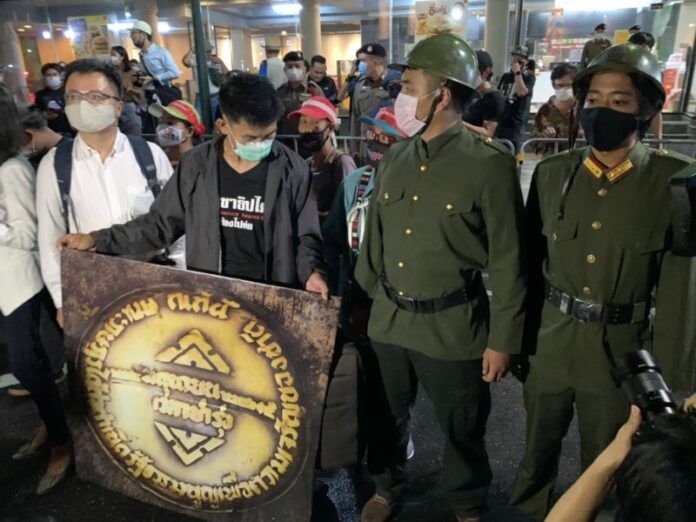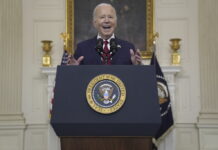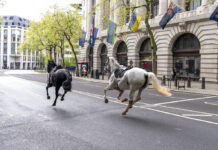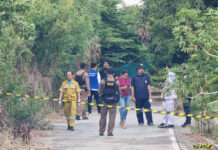
In what is tantamount to a declaration of war on history, the army earlier this week offered an alternative narrative of what happened on June 24 , 1932, the day a revolt ended absolute monarchy 88 years ago.
For nearly nine decades, the People’s Party who led revolt is generally recognized for its effort to usher parliamentary democracy to Thailand, then known as Siam. But as the army now said, People’s Party was not only anti-democratic but even wanted to overthrow the Crown.
The new interpretation was issued by the army’s information center to explain a Buddhist ceremony held by the force on Wednesday – the 88th anniversary of the revolt – in memory of pro-monarch rebels who sought to restore absolute monarchy in 1933.
The failed royalist rebellion was led by Prince Boworadet and Phraya Si Sitthisongkhram. The ceremony took place at two rooms at the army headquarter renamed in honour of the two officers last October and inaugurated by no less than Prime Minister Gen Prayut Chan-ocha himself.
It’s worth reading a good part of the army’s statement and think about its implications.
“In 1932 a change of political system took place and was an important turning point in Thai history from absolute monarchy to democratic system. It was staged by a group who called themselves the People’s Party and it is considered a coup d’etat to overthrow the monarchy.
“In 1933, “Boworadet Rebellion”, the first rebellions since the 1932 change of administrative system was led by Prince Boworadet and his general Phraya Si Sitthisongkram. This is because His Serene Highness did not agree with the administrative way of Phraya Phahon Phonphayuhasena [then prime minister] which was dictatorial in nature.
“[The rebels] urged the government of Phraya Phahon to maintain the monarchy institution, make the government more democratic, and allow more scrutiny and limits of power by the parliament. This was done so the People’s Party would not become a tyranny.
“In the end, the rebellion did not succeed and the government defeated the rebels. The heroic deeds and sacrifice of Prince Boworadet and Phraya Si Sitthisongkhram deserved to be recognized as protectors of the monarchy institution and an attempt to ensure that Thailand has a truly democratic system.”
The army’s statement came two and half years after the mysterious removal of a monument commemorating the defeat of the Boworadet rebellion in Laksi area of Bangkok, the site where the decisive clash took place (It is probably just a coincidence and let’s try not to think too much).
Curiosity of the public, including the younger generation, was piqued by the strings of disappearances of not just the monument but the removal of statues of revolt leaders that was presage by the equally mysterious disappearance of the revolt plaque in April 2017.
The plaque has since emerged as an icon among activists and a most potent symbol of democracy in political pop culture.
In fact, on the same day the army was condemning the 1932 revolt, there were a dozen events in and outside Bangkok that received unprecedented attention.
The audience included a substantial presence of younger Thais who observed the June 24 revolt by gathering to listen to the reading of the first proclamation of the People’s Party, who announced not just the end of absolute monarchy but went on to confirm that the country belongs to all Thais.
It seems a new young generation is coming of age, so to speak.
The proclamation itself has over the past few decades become sensitive in a political climate where royalism is making a comeback, however, and the act of rereading it out loud in a few places where they gathered certainly takes a lot of courage.
While the soldiers had no problem honouring the failed Boworadet Rebellion, the experience was different for some of those who led the commemorations of the 1932 revolt from a pro-democracy perspective
Student activist Parit Chiwarak said he was trailed by a suspicious vehicle after leaving a protest site the Wednesday evening gathering marking the 88th anniversary of the revolution.
Later that night and also in Bangkok, a street artist who goes by the name of “Headache Stencil” posted on his popular Facebook account was stalked by four men after he projected an image of a 1932 coup co-leader on the wall of the Grand Palace.
The street artist told me on the phone the men told his condominium guard that they were police officers but did not produce their IDs. They kept loitering at the condominium from 10.30pm to midnight. The artist returned to his condominium after midnight.
Feeling unsafe and told by the condominium security to leave, the artist fled by car and was trailed by the men before he managed to lose them.
However, police spokesman Pol Col Kissana Phathanacharoen insisted to me that he has no knowledge of police harassing the artist.
It seems the clash over who is on the right side of history is renewed once again, pitting the many youths who attended various commemorations of the June 24 revolt against the aging generals in charge of the army.
After 88 years, a truly decisive victory from either side has yet to be achieved. Now, both sides of the Thai political divide are not content with just fighting about the present but digging into the past and invoking it to legitimize their present confrontation.













































